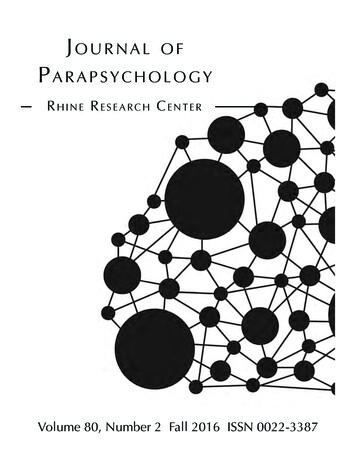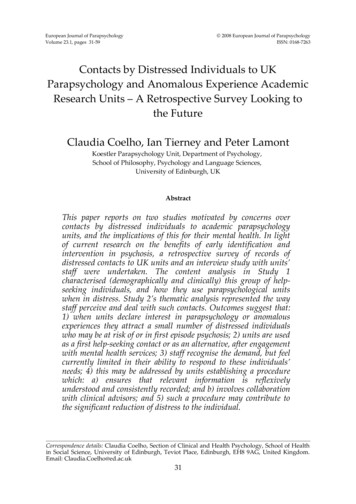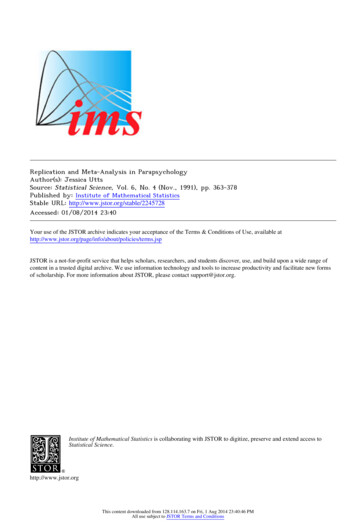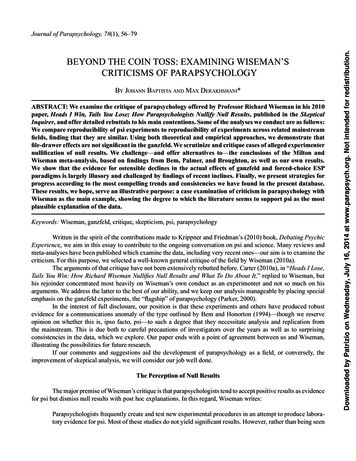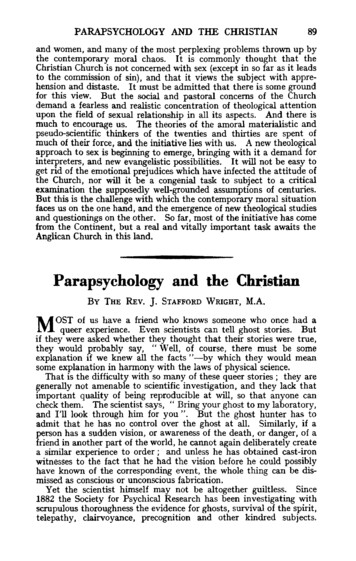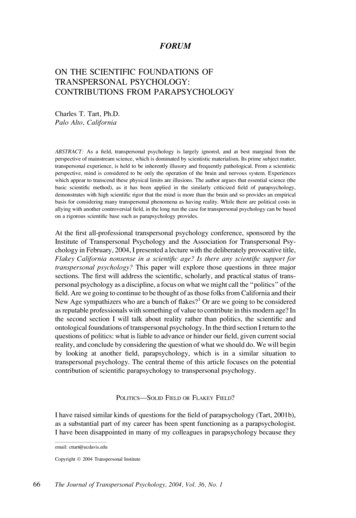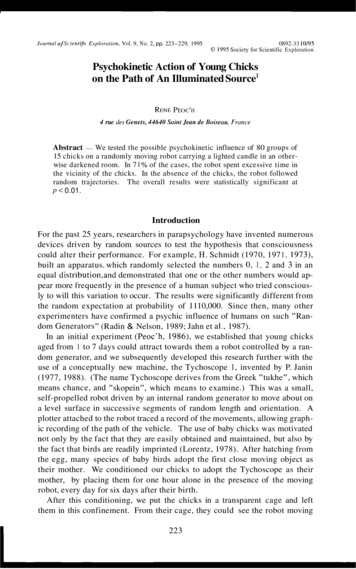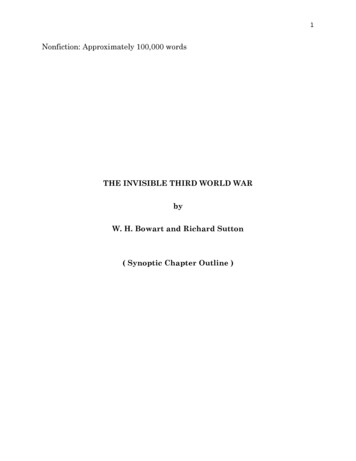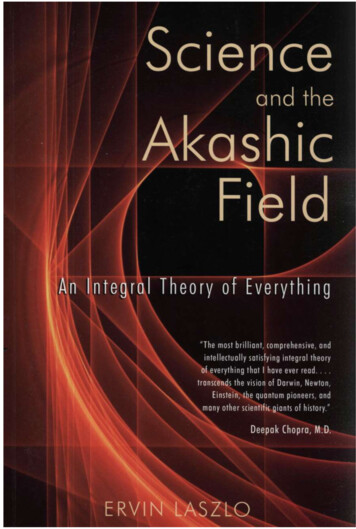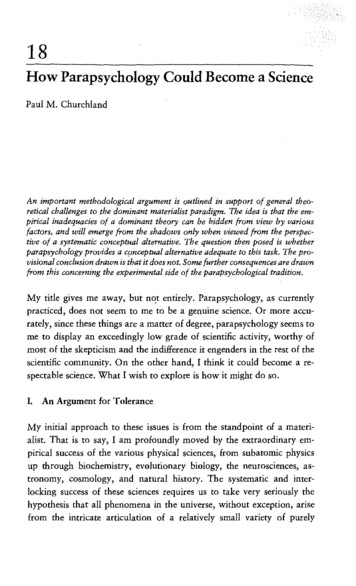
Transcription
18How Parapsychology Could Become a SciencePaul M. ChurchlandAn important methodological argument is outlined in support of general theoretical challenges to the dominant materialist paradigm. The idea is that the empirical inadequacies of a dominant theory can be hidden from view by variousand will emerge from the shadows only when viewed from the perspective of a systematic conceptual alternative. The question then posed is whetherparapsychology provides a cpnceptual alternative adequate to this task. The provisional conclusion drawn is that it does not. Some further consequences are drawnfrom this concerning the experimental side of the parapsychological tradition.My title gives me away, but not entirely. Parapsychology, as currentlypracticed, does not seem to me to be a genuine science. Or more accurately, since these things are a matter of degree, parapsychology seems tome to display an exceedingly low grade of scientific activity, worthy ofmost of the skepticism and the indifference it engenders in the rest of thescientific community. On the other hand, I think it could become a respectable science. What I wish to explore is how it might do so.I. An Argument for ToleranceMy initial approach to these issues is from the stand point of a materialist. That is to say, I am profoundly moved by the extraordinary empirical success of the various physical sciences, from subatomic physicsup through biochemistry, evolutionary biology, the neurosciences, astronomy, cosmology, and natural history. The systematic and interlocking success of these sciences requires us to take very seriously thehypothesis that all phenomena in the universe, without exception, arisefrom the intricate articulation of a relatively small variety of purely
306III. The Philosophy of Sciencephysical elements acting in accordance with a relatively small variety ofpurely physical laws.In particular, it seems overwhelmingly likely to me that all of the phenomena displayed in sentient creatures are likewise just a further instanceand articulation of the properties of law-governed physical matter. We areevidently made of matter. We evolved, by a complex but purely physicalprocess, from earlier and simpler organisms, also made of matter, whoselineage leads us back to a purely chemical primordial soup. And oursensory, cognitive, and motor activities, to the extent that we understandthem, are just a further mix of chemical, electrical, and mechanicalgoings on. The appeal of this broadly grounded conceptual frameworkis one of the principal reasons why the vast majority of scientists findclaims of "psychic" phenomena to be so implausible, for"these claims areincompatible with the materialist's well-grounded conception of theuniverse and our place in it.On the other hand, I am sensible that this standpoint may be mistaken.Its explanatory success to date, no matter how broadly based, does notguarantee its truth. Other frameworks, at other points in history, haveenjoyed a similar dominion over the range of human experience, yet haveproved in the end to be quite wrong. The organismic Aristotelian hegemony comes to mind here. In that case, it was the very comprehensiveness of the overall world-view that tended to blind us to the many failuresthat became apparent under close focus. Perhaps the modern materialistis similarly blinkered. And perhaps the research carried out under thebanner of parapsychology is just the sort we need to set us free.How likely this is, we shall discuss in due course. We shall have toweigh the systematic success of the physical sciences against the claims ofthe parapsychologists, who will insist that there are a variety of experimental results that cannot be explained in terms of existing physicalscience. I am going to avoid this empirical issue for a few more pages,however, since there is a purely methodological argument that can beraised in support of the. rationality of pursuing parapsychological research, however strong might be the substantive evidential position enjoyed by materialism.The argument derives from Paul Feyerabend (1963b), and has nothingessential to do with the virtues or vices of parapsychology. Feyerabend
18. How Parapsychology Could Become a Science307points out that sometimes the only way to discover the truly significantempirical inadequacies in an old and deeply entrenched theory is to construct alternative theories with which to provide entirely new interpretations of the old and familiar experimental data. Any successfultheory quite properly ignores or suppresses a good deal of faintly troublesome empirical evidence as irrelevant and inevitable "noise." Notheory ever fits all of the experimental data perfectly, if for no other reason than that the experimental situations that test them always embody ahorizon of subtle detail beyond which we have neither knowledge norcontrol. Over that horizon lie the inevitable elements that are too minor,too complex, and too inaccessible to be worth trying to unravel or controL Small discrepancies berween the favored theory and the results ofexperiment can therefore often be ascribed to the noisy activity of factorsjust over the horizon of controllable detail.There is no essential vic;e in this. The alternative is to try to control theposition and character of every particle in the universe. Instead, we control as much as we think it is necessary and prudent to control, and letthe rest go. And those experimental areas where we cannot hope to control the details we do believe to be relevant, we simply avoid as intractable and untevealing. The favored theory may not illuminate them, butits current "failure" to do so is not regarded as any strike against it.It remains possible, however, that the important empirical facts thatreflect the falsehood of the favored and so far "successful" theory are tobe found in precisely those experimental areas thought to be intractable,or are to be found just over the horizon of controlled detail in areas thatare tractable. In such cases the favored theory enjoys a safety from refutation that it does not deserve. The refuting facts are there, but for complex reasons they are difficult or impossible to see, at least while wecontinue to interpret the situation in terms of the favored theory. For itis that same theory that helps us decide which details are relevant andwhich are irrelevant, and which situations are tractable and which areintractable.The best way to escape from such a predicament, suggests Feyerabend,is to construct a comparably general alternative theory with which togenerate endrely n'ew interpretations of the experimental data, of whichdetails are and are not relevant, and of which situations are and are not
308III. The Philosophy of Sciencetractable. This can have the effect of highlighting certain details hithertosuppressed, of pulling new signal out of old noise, and of discoveringimportant order where before we saw only chaos. In particular, such areconfigured vision can reveal dramatic failures in the old theory, failuresthat were invisible, as failures, from within the old framework.Feyerabend provides a striking example of this phenomenon, which isworth a brief summary. The reader will forgive me if I oversimplify thephysics somewhat in order to highlight the methodological point.The "old entrenched theory" of this story is the classical theory of heatand energy, which contained as one of its central elements the principlethat all mechanical interactions involve at least some conversion of themechanical energy involved into heat. This means that any isolated system of bodies in motion mllst eventually "run down," in-the way that theballs on a billiard table, after bouncing off the cushion and each other fora time, come eventually to rest, their kinetic (mechanical) energy havingbeen dissipated throughout the system in the form of heat. They, and thecushions, and the surrounding air, have a slightly higher temperaturethan they did before being set in motion.The important point here is the generality of the principle-called thesecond law of Classical Thermodynamics. According to this principle, anysystem of mechanical interactions closed.to the entry of outside energya turning flywheel, an oscillating pendulum, a swarm of Ping-Pong ballsbouncing in a box-must eventually run down and come to rest.The "important falsifying phenomenon" of this story is Brownianmotion, discovered by the botanist Robert Brown in the early nineteenthcentury. Brownian motion is the ceaseless agitation of microscopic particles suspended in water or air, such as plant spores or smoke particles.The chaotic and apparently undiminished motion of such particles can beseen, and often was seen, through a microscope, but it was not seen tohave anything crucial to do with classical thermodynamics and the secondlaw. Brown's initial guess as to the nature of this barely detectable motionappealed to biology: the spores after all, were alive. The equally activebut lifeless smoke particles scotched that hypothesis, but there was stillno significant threat to the second law. Who could be sure whether ornot new energy was constantly being supplied from some microscopicsource, and who could possibly compile an accurate energy budget forsuch fantastically small particles or the diffuse medium in which they
18. How Parapsychology Could Become a Science309were suspended, in order to see whether or not it all squared with thedemands of the classical theory? Such things were beyond experimentaldetermination. And so Brownian motion remained at most a minor puzzleto the classical theorist, if it was noticed at all, which for the most part itwasn't. The classical theory strode the landscape like an unchallengedgiant.But not for long. An alternative and comparably general theory of heatwas eventually developed, from motives that had nothing to do withBrownian motion. This theory-the modern kinetic theory of heatproposed that heat energy is nothing but a special case of mechanical(kinetic) energy, to wit, the mechanical energy of the molecules of whichcommon solids, liquids, and gases are composed. They too have motion,bouncing around chaotically or oscillating busily away down at thesubmicroscopic level. The temperature of any body was claimed to benothing but a measure of ,how vigorously its constituent molecules areknocking about. And the inevitable "conversion" of macrolevel kineticenergy into heat, so insisted upon by the classical second law, turns outto be nothing but the redistribution of kinetic energy from the macro- tothe microlevel. A bouncing ball eventually comes to rest, but only becauseits chaotically bustling molecules, and those of the air and the floor, eachtake on a tiny part of the motion that used to be so coherently lodged inthe unified motion of the ball as a whole. The ball is now still, but faintlywarmer, as is the floor and the surrounding air. The ball's original energylives on as an increase in the activity of its bustling molecules, and .of themolecules of the floor and the surrounding air.But what of the bouncing molecules themselves? Will they not dissipate their kinetic energy as they bounce off each other, just as the balldoes? Will they not come finally to rest also-still, but faintly warmer?No, said the kinetic theory. Molecular interactions are perfectly elasticwhich is just another way of saying that no energy is lost in any suchinteraction-and so the particles go on bouncing happily away forever.Molecules cannot dissipate t!.teir kinetic energy away into heat, becausetheir motion is already what constitutes heat. A closed system of bouncing molecules, therefore, will never run down.This theory was not well received by the majority, and understandablyso. For one thing, it postulated entities of a size that specifically precludedtheir ever being observed by humans. And for another, these constitu-
310III. The Philosophy of Sciencetionally "shy" particles were supposed to be perfectly (perfectly) elasticin their mutual collisions, in direct contradiction to the well-foundedclassical second law. On the face of things, it was both methodologicallysuspect and factually improbable.How to test this startling new theory concerning the nature of heat?There were many ways, but only one of them need concern us here.Molecules were too small to be seen, even with a microscope, so therewas clearly no hope of seeing directly whether a warm gas consists ofmolecules in ceaseless motion. However, if we suspend particles in thegas, particles small enough to be knocked around by the bustling gasmolecules on every side, but latge enough to be seen, at least with amicroscope, then the ceaseless motion of the molecules will be reflected ina ceaseless dance on the part of the suspended particles. That is to say, ifthe kinetic theory of heat is true, then Brownian motion ought to exist!Futhermore, the violence of that motion should be directly proportionalto the absolute temperature of the gas (the faster the molecules aremoving, the more the smoke particles will be bounced around); and theviolence of that motion should be inversely proportional to the size of thesuspended smoke particles (the smaller the smoke particles, the moreeasily they will be shoved around). Further still, the kinetic theory madepredictions about the gravitational distribution of smoke particles as afunction of temperature, and it yielded a nice derivation of the classicalgas law as well. But we need not go into these here. Suffice it to say thatall of these predictions were experimentally accessible, and all of themwere corroborated in detail.In this way did a minor curiosity, of dubious relevance to anything,emerge as a major phenomenon. It revealed the hidden character of bothmatter and heat, and it constituted a standing refutation of the classicalsecond law. But it did so only because a new theory showed us a newway to make sense of it. Had we stuck to the categories and vision of theclassical theory, the significance of Brownian motion might never havebeen appreciated.The moral of the story is that we should always be tolerant of theproliferation of theoretical viewpoints. Indeed, we should actively encourage it, even if our current theories suffer no obvious empiricalshortcomings. This does not mean that we should put aside successful
18. How Parapsychology Could Become a Science311theories and productive research programs in order to pursue every cockamamy idea that comes down the pike. That would be uncritical, irresponsible, and monstrously inefficient. But it does mean that we shouldbe wary of conceptual monopoly, however well earned. And it means weshould always be solicitous of genuine attempts to articulate and exploreinteresting conceptual alternatives.ll.Parapsychology: The Theoretical SideCan we properly apply this moral to the case of parapsychology? I believe we can. But it has not been my aim to conjure up a limp apologiafor "psychic" explorations, and then walk away. What I have in mind,rather, is this. The kinetic theory of heat is a clear example of a scientificsuccess won against great odds. What general features of that theory,and/or what features of the methodology of its proponents, made it sucha success? If we can answer this question, then we can confront the nextlogical question. Do the theories proposed and the methodology displayed by the proponents of parapsychology have anything like the samevirtuous features displayed in out benchmark case? Let us see.The first advantage possessed by the kinetic theorists was a systematicand detailed al[ernative theory concerning the phenomena in quesdon.The new theory specified that any gas, for example, was constituted bya large number of perfectly elastic particles having -mass, volume, andvelocity. It told us that the steady pressure exerted by the gas on the wallsof any container is just the effect of the particles repeatedly bouncing offit. It stated that the total heat in any system is the sum of the kinetic energy of all its molecules. It told us that the global temperature of thesystem is just the kinetic energy level of one of its average molecules. Andsince the notions of mass, velocity, and kinetic energy were quite wellunderstood by then, the whole range of submicroscopic activity could beaddressed with the language and the laws of classical Newtonian mechanics. Kinetic theorists could address the phenomena confronting themwith an impressive array of theoretical resources.Of course there were many things that remained to be unraveled-themass and velocity of the proposed corpuscles, the different heat capacitiesdisplayed by different substances, and the disappearance of latent heat
312III, The Philosophy of Scienceduring melting and boiling, But the theory itself suggested very definitetheoretical and experimental approaches to these problems, approachesthat bore fruit in surprisingly short order. In the absence of such a specific, powerful, and highly detailed theory, such progress could not havebeen made.Does parapsychology possess any significant body of theory concerning what the nonmaterial mind is like, a theory of what nonphysical elements compose it, and what nonphysical laws govern their interactionswith each other and with the various aspects of the material world? Letme emphasize that this question concerns only the existence of relevanttheory, not its verification. Does parapsychology have any significantbody of generally shared theory with which to even address the empiricalphenomena? The embarrassing fact is that it does not. A search throughthe pages of the Journal of Parapsychology, one of the more respectableorgans of parapsychological communication, will discover many experiments designed to reveal some surprising capacity on the part of humansor animals, But the reader will find almost nothing in the way of positive,systematic, and well-defined theory concerning the nature of mentalsubstance or mental properties and the quantitative or formal laws thatgovern their interaction and behavior.Such theory as one does find is vague, impressionistic, and nonquantitative; it is usually aimed at a very narrow range of phenomena;and it is almost always idiosyncratic to the author. There is no settledcore of theory whose past successes have unified the community behindit, whose current form has been shaped in response to past experimentalfailures, and whose experimental agenda drives the assembled disciplineforward. These elements, so central to establishedare poignantly missing in the case at issue. To a philosopher or historian of science,parapsychology appears as a strikingly atheoretical discipline. Beyondthe vague assumption that conscious agents have a nonphysical aspect ofsome kind, which gets somehow expressed in occasional displays ofparanormal perception or paranormal manipulation, there is simply noaccepted core of general theory to be found.What one does find is a great deal of predominantly experimentalresearch, aimed at isolating and demonstrating effects that transcendexplanation in terms of physical science. Characteristically, such experi-
18. How Parapsychology Could Become a Science313ments are concerned to identify cases of successful perception of somekind or other, where perception is thought to be physically impossible(e.g., remote viewing, telepathy, clairvoyance); or they are concerned toidentify cases of successful control or manipulation of some kind, wherecontrol is thought to be physically impossible (e.g., psychokinesis, telepathy). These experiments are often very elaborate, exploiting the samerange of high-tech electronic equipment found in established branches ofscience, and they exploit the very same techniques of statistical evaluation approved elsewhere. In fact, the experimental drill is so well-oiledthat it can be directed at any arbitrary set of variables among which onemight suspect a statistically significant relationship.As a result, parapsychological research has the collective character ofa mass fishing expedition. Lacking any general theory with which todiscriminate one part of the lake from another, one drops one's experimentalline wherever local impulse suggests that one do so. The collective result is a jumble of ill-motivated results that move the disciplinein no particular direction, because they motivate no widely acceptedmodifications to the core of guiding theory. For there is no such core.There are further problems with the methodology of looking for someeffect, any effect, that cannot be accounted for in normal physical terms.For when such results are achieved (or rather, are alleged to be achieved),the results may indeed be mysterious from a physical point of view, butthey remain equally mysterious from the nonphysical point of view. Thereason is that the parapsychologists are no better able to provide an explanation than are the physicists, for parapsychology has no significanttheoretical resources with which to construct any explanations. If someone predicts the results of a long series of coin tosses with 100 percentaccuracy, it is no explanation of this surprising result simply to say thatthe subject "has precognition." As well explain why sodium amy tal putsyou to sleep ,by saying it "has a dormative virtue." A real explanationwould cite the nonphysical mechanisms involved, identify the empiricalfacts that reflect them, appeal to the laws that govern them, and thendeduce exactly the surprising effect observed. Parapsychology does noneof these things.Contrast all of this with the case of the kinetic theory of heat. The experimental research conducted by the kinetic theorists was not aimed at
314III. The Philosophy of Sciencefinding experimental results that could not be accounted for by the classical theory. It was aimed at testing the specific provisions of the kinetictheory. When experimental successes were achieved, they were successesnot principally or even usually because they defied any classical explanation, but because they yielded even more accurately to explanation andprediction in terms of the kinetic-corpuscular theory. The kinetic theorydid not shine by reflected failure; it shone by its own light.In contrast, parapsychology shines only by the reflected failures ofmaterialism, if it shines ar all. Parapsychology has no explanatory successes it can call its own, because it has no substantial theory it can callits own. If there is no detailed theory, there can be no detailed explanations. And if there are no detailed explanations, then parapsychologycannot shine with its own light.The want of significant theory, therefore, is a very serious deficit. Buteven more seriolls, I believe, is the lack of any movement on· the partof the parapsychological community, throughout its entire history, toattempt to repair rhisyawning deficit. Rather, professional concern hasalways been centered on anecdotes about past or current psychic marvels,and/or on experiments designed to uncover a clearly paraphysical effect.But no effecr, no matter how startling, can be confidently identified as"para physical" unless the effect finds a uniquely successful explanationin terms of some detailed paraphysical theory. In the absence of such anexplanatory success, the surprising effect will be no more than that. Itwill be just another surprising and currently unexplained effect. Thereneed be nothing remotely "paraphysical" about it.Accordingly, the dogged experimental pursuit of paraphysical resultswithin a vacuum of genuine paraphysical theory seems to me to bemethodologically barren, even if the experiments are performed withmeticulolls care, and even if they produce some genuinely puzzling results. Brownian motion was also a deeply puzzling result, and it too wasfound by respectable researchers using respectable techniques. But it didnot count a fig against classical thermodynamics, nor would it ever havedone so, save that the new kinetic theoty finally gave intelligible form toits significance. What parapsychology needs more than anything else,therefore, is some specific and substantial theory, to give form to itsvague aspirations, and systematic guidance to its experimental activity.
18. How Parapsychology Could Become a Science315So long as it lacks such theory, it will never be a science, no matter howmany experiments it accumulates.There is a methodological vice with which all of us are familiar. Philosophers are especially familiar with it, since they have sO often been(justly) accused of displaying it. The vice consists in the attempt to makelarge-scale theoretical progress in the absence of any systematic experimental input to control the ongoing development of theorl::' The result is"castles in the air." Those who proceed in this fashion will protest thatthey are theorists. And so they are. They will protest that their theoriesare coherent and imaginative. And so they may be. But the overall procedure falls well short of being science.That vice has a converse, less commonly seen, but just as barren in itsoutput. This second vice consists in the attempt to make large-scale experimental progress in the absence of any systematic theory to guide theexperimental tradition, and to be modified in light of the outcomes. Theresult is a bin of meaningless correlations among parameters of questionable significance. Those whose proceed in this fashion will protestthat they are genuine experimentalists. And so they are. They will protestthat the experiments are honestly and accurately performed. And so theymay be. But the overall procedure falls well short of being science. Likethe preceding aspirants, such people are just playing at being scientists.In advance of examining the parapsychological tradition, as represented in the pages of its own journal, one might have guessed that itsuffers primarily from the first defect. But of these two maladies, it isnot the first, I assert, but the second, that most closely characterizes theweakness of parapsychology.III. Parapsychology: The Experimental SideI have already leveled my major criticism of the experimental tradition ofparapsychology. It is a methodological criticism, and it implies nothinguntoward about the honesty or the critical care of those who conduct therelevant experiments. The discussion to this point has been deliberatelyuncritical in its representation of the reliability of the experimental resultsof parapsychology. That is because the validity of the methodologicalcriticism I have been concerned to make is quite independent of how
316III. The Philosophy of Sciencereliable those results might be. But it would be misleading of me toleave the reader with the impression that there are any generally acceptedresults in this area. Certainly there are none that are widely acceptedoutside the relatively small parapsychological community. There is as yetno experimental analog to Brownian motion on which they, and we,might chew.In fact, it is not clear that they have any interesting and repeatablepositive results at all. The history of the subject is full of major and minorscandals, ranging from the engineered seances of the '20s and '308, to thedeliberate manufacture of false data by the renowned S.G. Soal in the'40s, to the gizmo-aided "psychophotography" of T. Serios iii the '60s,to the hopelessly ill-controlled experiments of R. Targ and H. Puthoffcentered on Uri Geller (an undeclared but highly skilled magician) in the'70s. These comic operas, and others, have been discllssed at lengthelsewhere (Randi, 1982), and so I shall not pursue them here. But theyare worth mentioning, and not just because they were scandals. Thesecases are a sobering lesson because each was widely held in its time toconstitute the best evidence of paranormal phenomena ever advanced.And they are further worth mentioning because the frailties they recordare endemic to the human soul.On the other hand, we cannot tar everyone with the brush of fools, noreven the majority. Parapsychologists quite often report wholly negativeresults, and what better testament to honesty than this? What we wantto know is, what should we make of those few studies, apparently conducted with scrupulous care and integrity, which show statistically significant deviations from what we think is physically explicable?There is no completely general answer that is adequate to this question. Each case should be dealt with on its own merits. But one thing wecan demand, before we get too excited about any given case, is that theresult be replicated, preferably by an independent laboratory. The reasons for this have nothing particular to do with either mendacity or stupidity. If, during five years of parapsychological research, 1000 statisticalexperiments are performed with perfect care and honesty, we are boundto get a very small percentage of cases that nudge or exceed the level of"significance," on statistical grounds alone. That is to say, there will bea small handful of "positive" results, even if there is nothing to para-
18. How Parapsychology Could Become a Science317psychology, and even if the investigators are scrupulous and the experimental protocols faultless.This handful, we may assume, gets published. But consider. If 500 ofthe original 1000 experiments are forgotten because their disappointedinvestigators decide to pursue career development in other directions;and if 400 of the remaining 500 experiments are forgotten because theyalso were negative, and their investigators undertake further experimentswhich constitute the remaining 100; and if 80 of these, though honestlysubmitted, are never published because the editors are impatient withyet more negative parapsychological results; then the "accidentally significant" handful of positive results-say, 3 or 4 of the original 1000experiments-will be published against an apparent sample of only 20published experiments. They will thus appear to have a signif
parapsychology provides a cpnceptual alternative adequate to this task. The pro-visional conclusion drawn is that it does not. Some further consequences are drawn from this concerning the experimental side of the parapsychological tradition. My title gives me away, but not entirely. Parapsychology, as currently
